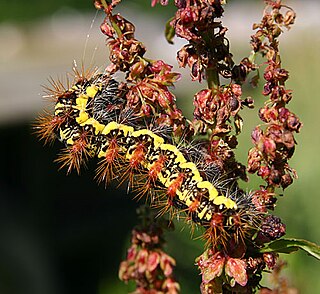
Acronicta is a genus of noctuid moths containing about 150 species distributed mainly in the temperate Holarctic, with some in adjacent subtropical regions. The genus was erected by Carl Linnaeus in his 1758 10th edition of Systema Naturae. Caterpillars of most Acronicta species are unmistakable, with brightly colored hairy spikes, and often feed quite visibly on common foliate trees. The hairy spikes may contain poison, which cause itchy, painful, swollen rash in humans on contact. The larva of the smeared dagger moth is unusually hairy even for this genus. Acronicta species are generally known as dagger moths, as most have one or more black dagger-shaped markings on their forewing uppersides. But some species have a conspicuous dark ring marking instead.

Acronicta lanceolaria, the lanceolate dagger moth or pointed dagger, is a moth of the family Noctuidae. The species was first described by Augustus Radcliffe Grote in 1875. It is found in North America, from Nova Scotia to British Columbia. It is listed as a species of special concern and believed extirpated in the US state of Connecticut.

Acronicta lobeliae, the lobelia dagger moth or greater oak dagger moth, is a moth of the family Noctuidae. The species was first described by Achille Guenée in 1852. It is found in North America.

Acronicta oblinita, the smeared dagger moth or arioch dagger, is a moth of the family Noctuidae. The species was first described by James Edward Smith in 1797. It is found in eastern North America, from Nova Scotia west across Canada to British Columbia, north to Lake Athabasca and south to Florida and Texas.

Thliptoceras is a genus of moths of the family Crambidae. The genus was erected by William Warren in 1890.
Hepsidera is a genus of moths of the family Erebidae. The genus was erected by Charles Swinhoe in 1902.
Mecodina is a genus of moths of the family Erebidae first described by Achille Guenée in 1852.

Rivula is a genus of moths in the family Erebidae described by Achille Guenée in 1845.

Pseudeuchlora is a monotypic moth genus in the family Geometridae erected by George Hampson in 1895. Its only species, Pseudeuchlora kafebera, was first described by Charles Swinhoe in 1894. It is found in Asia, including India.

Acronicta lepusculina, the cottonwood dagger moth, is a moth of the family Noctuidae. The species was first described by Achille Guenée in 1852. It is found in most of eastern North America, west through southern Canada to Vancouver Island and southward.

Acronicta impressa, the impressive dagger moth or willow dagger moth, is a moth of the family Noctuidae. The species was first described by Francis Walker in 1856. It is found from western Canada to north-western Mexico.

Acronicta interrupta, the interrupted dagger moth, is a moth of the family Noctuidae. The species was first described by Achille Guenée in 1852. It is found across southern Canada south of the boreal forest, from New Brunswick west to eastern Alberta, south to Georgia, Nebraska and Arizona.
Acronicta vulpina, the vulpina dagger moth or miller dagger moth, is a moth of the family Noctuidae. The species was first described by Augustus Radcliffe Grote in 1883. It is found in North America from New York and Newfoundland west to central British Columbia, south to Colorado.

Acronicta hamamelis, the witch hazel dagger moth or puzzling dagger moth, is a moth of the family Noctuidae. The species was first described by Achille Guenée in 1852. It is found in Canada and parts of the United States, including Maryland.

Acronicta heitzmani, or Heitzman's dagger moth, is a moth of the family Noctuidae. The species was first described by Charles V. Covell and Eric H. Metzler in 1992. It is found in Missouri, Arkansas, Illinois and Ohio.

Acronicta laetifica, the pleasant dagger moth, is a moth of the family Noctuidae. The species was first described by John Bernhardt Smith in 1897. It is found in North America from Nova Scotia to Florida, west to Texas, north to Manitoba.

Acronicta inclara, the unclear dagger moth, is a moth of the family Noctuidae. The species was first described by John Bernhardt Smith in 1900. It is found in north-eastern North America.

Acronicta iria is a moth of the family Noctuidae first described by Charles Swinhoe in 1899. It is found in India.

Mesoptila melanolopha is a moth in the family Geometridae first described by Charles Swinhoe in 1895. It is found in Nepal, China, Korea, Japan, Taiwan, India, Sri Lanka, Thailand, Vietnam, Malaysia and on Java, Bali and Borneo.








